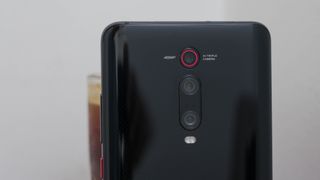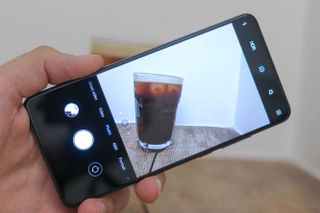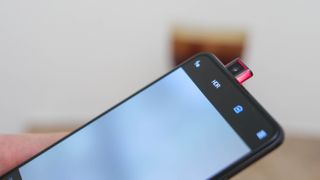Why you can trust TechRadar
Battery life
- 4,000mAh battery
- 18W charger included, 27W supported
- No wireless charging
The Xiaomi Mi 9T Pro packs the same capacity battery as the new Xiaomi Mi Mix 3 5G, 4,000mAh, which is a healthy bump up from the 3,300mAh cell in the original Mi 9.
The Mi 9’s battery wasn’t bad, but the Mi 9T Pro’s is bordering on great. It easily makes it through from morning to night with about 20% left in the tank, and a 90-minute Full HD video played back at full brightness only depleted it by 10%.
The Mi 9T Pro also supports fast charging, up to 27W, though ships with an 18W QuickCharge 3 charger. Don’t let your hopes for fast-fueling get dashed too quickly though; 10 minutes of charge powered it up by 15%, 30 minutes by 48% and after just over an hour, it was 100% full with the supplied charger.

That’s incredibly quick, especially compared to the iPhone XS Max’s very slow charging time of 3 hours 30 minutes with its supplied charger.
The phone also has software features to monitor battery usage so you can track down rogue apps, or taper background connectivity and activity if you need the Mi 9T Pro to last that bit longer.

Camera
- Triple rear camera
- 20MP pop-up selfie camera
- 4K video at 60fps
With three cameras around the back, the Xiaomi Mi 9T Pro is a very familiar beast, packing a wide, ultra-wide and telephoto angle-of-view. That’s the same setup as found on the Sony Xperia 1 and LG V50 ThinQ, and has fast become the new normal for a flagship smartphone camera array.
Shooting modes are plentiful, ranging from automatic with ‘AI’ scene detection through to Pro mode, enabling full manual control over photos taken. While there aren’t any out of the ordinary modes, the handy feature Xiaomi phones include is a 48MP shortcut, for full-resolution photos that can capture incredible amounts of detail if the light is right.
As far as image quality goes, the Mi 9T Pro shoots 12MP images by default. In great lighting, there’s very little to complain about, beyond the Xiaomi watermark that appears in the bottom right of every photo you take until you switch it off in the settings - this really should be off by default from a user experience point of view.

When lighting gets tougher in the form of either backlit or front-lit scenes, the phone has an HDR feature that’s switched off by default. We would recommend firing up auto-HDR as nine out of ten shots we captured looked better with HDR on.
Images shot on the Mi 9T Pro manage to capture plenty of detail with colors that pop nicely, especially when you fire up the smart scene detection. Greens can be a little overzealous though, and blacks pick up a bit more noise than higher-end flagships like the Huawei P30 Pro and Samsung Galaxy S10 - particularly noticeable when shooting dark, textured objects, like black cats.
Despite this, it copes well with low light scenes, with a dedicated night mode loaded up to help things along. None of the cameras feature optical image stabilization, but Xiaomi employs similar computational photography smarts to those used by Huawei and Google to grab a long-exposure shot and pull out more detail even when the lights go down.

Again, the results won’t compete with the best out there, but still best almost all the sub-£400/$500 competition, and even outshine the much pricier iPhone XS.
Video is captured at up to 60fps in 4K resolution, and when it comes to smartphones today, it doesn’t get better than that. The picture is epic in ideal lighting when recording on a tripod at max quality.
If you don’t have a tripod or steady surface though, the hand-shake it picks up is also epic - and not in a good way. Luckily, drop the 4K frame rate down to 30fps and things smooth out, with the electronic image stabilization being very effective.
Meanwhile, when the lights drop, you will want to reduce the resolution to Full HD to get the best from it, and in very dark scenes, the Mi 9T Pro calls it a day, along with most of the smartphone population.

Finally, the pop-up selfie camera is a lot of fun. You can capture vanilla selfies if you like, but the portrait mode also comes loaded up with a host of effects, overlaying rainbows over your scene, a streak of light, or changing your backdrop entirely.
Selfie quality is respectable, and while it isn’t a low-light whizz like its rear-camera counterpart, the selfie snapper uses the screen as a flash to great effect.
Camera samples









Current page: Battery life and camera
Prev Page Introduction, design and display Next Page Anything else I should know?Basil Kronfli is the Head of content at Make Honey and freelance technology journalist. He is an experienced writer and producer and is skilled in video production, and runs the technology YouTube channel TechEdit.

